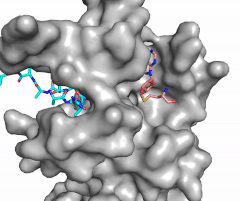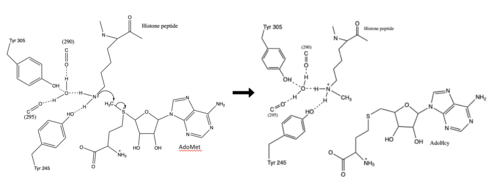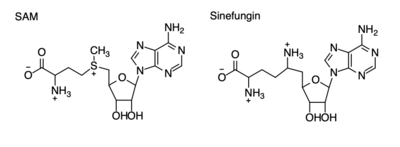User:Ashley Crotteau/Sandbox1
From Proteopedia
(Difference between revisions)
| Line 24: | Line 24: | ||
The most notable feature of the HKMT is the presence of the lysine access channel as the active site. The cofactor and <scene name='81/811708/Sam_structure/3'>peptide</scene> substrate are located on opposite sides of the SET domain but are connected through this narrow channel (Figure 1).<ref name="Xiao" /> This channel allows these two components to interact and complete the methyltransfer. The active site in general is considerably tyrosine rich. Residues Tyr245, His297, Ser268, Tyr305, Tyr335, and Tyr337 all help to shape the <scene name='81/811707/Stick_active_site/2'>active site</scene> and the channel.<ref name="Xiao" /> The cofactor involved, SAM, provides the methyl for methylation of the lysine on its sulfur atom. | The most notable feature of the HKMT is the presence of the lysine access channel as the active site. The cofactor and <scene name='81/811708/Sam_structure/3'>peptide</scene> substrate are located on opposite sides of the SET domain but are connected through this narrow channel (Figure 1).<ref name="Xiao" /> This channel allows these two components to interact and complete the methyltransfer. The active site in general is considerably tyrosine rich. Residues Tyr245, His297, Ser268, Tyr305, Tyr335, and Tyr337 all help to shape the <scene name='81/811707/Stick_active_site/2'>active site</scene> and the channel.<ref name="Xiao" /> The cofactor involved, SAM, provides the methyl for methylation of the lysine on its sulfur atom. | ||
| - | [[Image:Water.PNG|300 px|right|thumb|Figure 2: Water being utilized in the active site]] | ||
| - | The beta hairpin stabilizes the <scene name='81/811707/Beta_hairpin_stabilizing_tyrs/1'>conformation of Tyr335 and Tyr337</scene>, while also shaping one side of the channel which the peptide binds to.<ref name="Xiao" /> The <scene name='81/811707/Peptide_binding_site/1'>peptide binding groove</scene> is composed of residues 255-268.<ref name="Xiao" /> Lysine would have trouble coming down into the active site in its charged form, but it is enabled by the faces of the flanking tyrosines.<ref name="Xiao" /> The lysine is oriented so that the amine-methyl bond is pointed towards the sulfur on SAM so that it can provide the methyl. There is an important water in the active site | + | The beta hairpin stabilizes the <scene name='81/811707/Beta_hairpin_stabilizing_tyrs/1'>conformation of Tyr335 and Tyr337</scene>, while also shaping one side of the channel which the peptide binds to.<ref name="Xiao" /> The <scene name='81/811707/Peptide_binding_site/1'>peptide binding groove</scene> is composed of residues 255-268.<ref name="Xiao" /> Lysine would have trouble coming down into the active site in its charged form, but it is enabled by the faces of the flanking tyrosines.<ref name="Xiao" /> The lysine is oriented so that the amine-methyl bond is pointed towards the sulfur on SAM so that it can provide the methyl. There is an important <scene name='81/811707/Water_interaction/1'>water</scene> in the active site that accepts a hydrogen bond from the lysine substrate, shifting the lone pair on the nitrogen towards the sulfur of SAM. <ref name="Xiao" /> |
== Function == | == Function == | ||
| - | [[Image:KMT Mechanism .png|500 px|right|thumb|Figure | + | [[Image:KMT Mechanism .png|500 px|right|thumb|Figure 2: Histone Methylation by HKMT Mechanism]] |
The N of the amine from the lysine serves as a nucleophile that attacks the electrophilic CH<sub>3</sub> that is present in the AdoMet (SAM). The sulfur that the CH<sub>3</sub> is attached to pulls the electrons towards itself to weaken the bond between the sulfur and the carbon. This weak bond allows for the N to break that bond and take the methyl group. The N on the lysine is being stabilized by Tyr residues and a water molecule (Figure 3). This allows the N to accept the methyl and take up that positive charge. | The N of the amine from the lysine serves as a nucleophile that attacks the electrophilic CH<sub>3</sub> that is present in the AdoMet (SAM). The sulfur that the CH<sub>3</sub> is attached to pulls the electrons towards itself to weaken the bond between the sulfur and the carbon. This weak bond allows for the N to break that bond and take the methyl group. The N on the lysine is being stabilized by Tyr residues and a water molecule (Figure 3). This allows the N to accept the methyl and take up that positive charge. | ||
| Line 40: | Line 39: | ||
===Renal Fibrosis=== | ===Renal Fibrosis=== | ||
| - | [[Image:Sam_vs_sinefungin.png|400 px|right|thumb|Figure | + | [[Image:Sam_vs_sinefungin.png|400 px|right|thumb|Figure 3: Structural differences between SAM and Sinefungin]] |
The inhibition of KMT SET 7/9 has been found to enhance renal fibrosis.<ref name="Sun" /> H3K4 methylation activates the transcription of fibrotic genes, and the suppression of the H3K4 methylation was found to enhance renal fibrosis in a mouse model.<ref name="Sun" /> Sinefungin, a competitive methyltransferase inhibitor, binds to KMT to inhibit SAM.<ref name="Sun" /> SAM and Sinefungin have similar structures (Figure 4), differing only with the removal of a sulfide and the replacement of a methyl to an amine. The amine replaces the methyl donor for the reaction of KMT, inhibiting the reaction and preventing methylation. Without the methylation of H3K4, the transcription of fibrotic genes is deactivated, leading to renal fibrosis.<ref name="Sun" /> | The inhibition of KMT SET 7/9 has been found to enhance renal fibrosis.<ref name="Sun" /> H3K4 methylation activates the transcription of fibrotic genes, and the suppression of the H3K4 methylation was found to enhance renal fibrosis in a mouse model.<ref name="Sun" /> Sinefungin, a competitive methyltransferase inhibitor, binds to KMT to inhibit SAM.<ref name="Sun" /> SAM and Sinefungin have similar structures (Figure 4), differing only with the removal of a sulfide and the replacement of a methyl to an amine. The amine replaces the methyl donor for the reaction of KMT, inhibiting the reaction and preventing methylation. Without the methylation of H3K4, the transcription of fibrotic genes is deactivated, leading to renal fibrosis.<ref name="Sun" /> | ||
Revision as of 19:52, 24 April 2019
H. sapiens Lysine Methyltransferase, SET 7/9
| |||||||||||
References
[3] [8] [5] [6] [7] [9] [10] [11] [1] [2] [4]
- ↑ 1.0 1.1 DesJarlais R, Tummino PJ. Role of Histone-Modifying Enzymes and Their Complexes in Regulation of Chromatin Biology. Biochemistry. 2016 Mar 22;55(11):1584-99. doi: 10.1021/acs.biochem.5b01210. Epub , 2016 Jan 26. PMID:26745824 doi:http://dx.doi.org/10.1021/acs.biochem.5b01210
- ↑ 2.0 2.1 Marino-Ramirez L, Kann MG, Shoemaker BA, Landsman D. Histone structure and nucleosome stability. Expert Rev Proteomics. 2005 Oct;2(5):719-29. PMID:16209651 doi:http://dx.doi.org/10.1586/14789450.2.5.719
- ↑ 3.00 3.01 3.02 3.03 3.04 3.05 3.06 3.07 3.08 3.09 3.10 Xiao B, Jing C, Wilson JR, Walker PA, Vasisht N, Kelly G, Howell S, Taylor IA, Blackburn GM, Gamblin SJ. Structure and catalytic mechanism of the human histone methyltransferase SET7/9. Nature. 2003 Feb 6;421(6923):652-6. Epub 2003 Jan 22. PMID:12540855 doi:10.1038/nature01378
- ↑ 4.0 4.1 4.2 doi: https://dx.doi.org/10.15406/mojcsr.2016.03.00047
- ↑ 5.0 5.1 5.2 5.3 5.4 5.5 5.6 Schubert HL, Blumenthal RM, Cheng X. Many paths to methyltransfer: a chronicle of convergence. Trends Biochem Sci. 2003 Jun;28(6):329-35. PMID:12826405
- ↑ 6.0 6.1 6.2 6.3 6.4 6.5 Yeates TO. Structures of SET domain proteins: protein lysine methyltransferases make their mark. Cell. 2002 Oct 4;111(1):5-7. PMID:12372294
- ↑ 7.0 7.1 Huang S, Shao G, Liu L. The PR domain of the Rb-binding zinc finger protein RIZ1 is a protein binding interface and is related to the SET domain functioning in chromatin-mediated gene expression. J Biol Chem. 1998 Jun 26;273(26):15933-9. PMID:9632640
- ↑ 8.0 8.1 doi: https://dx.doi.org/10.1016/C2014-0-02189-2
- ↑ 9.0 9.1 9.2 9.3 9.4 9.5 Del Rizzo PA, Couture JF, Dirk LM, Strunk BS, Roiko MS, Brunzelle JS, Houtz RL, Trievel RC. SET7/9 catalytic mutants reveal the role of active site water molecules in lysine multiple methylation. J Biol Chem. 2010 Oct 8;285(41):31849-58. Epub 2010 Aug 1. PMID:20675860 doi:http://dx.doi.org/10.1074/jbc.M110.114587
- ↑ 10.0 10.1 10.2 10.3 10.4 Sun G, Reddy MA, Yuan H, Lanting L, Kato M, Natarajan R. Epigenetic histone methylation modulates fibrotic gene expression. J Am Soc Nephrol. 2010 Dec;21(12):2069-80. doi: 10.1681/ASN.2010060633. Epub 2010, Oct 7. PMID:20930066 doi:http://dx.doi.org/10.1681/ASN.2010060633
- ↑ 11.0 11.1 Tian X, Zhang S, Liu HM, Zhang YB, Blair CA, Mercola D, Sassone-Corsi P, Zi X. Histone lysine-specific methyltransferases and demethylases in carcinogenesis: new targets for cancer therapy and prevention. Curr Cancer Drug Targets. 2013 Jun;13(5):558-79. doi:, 10.2174/1568009611313050007. PMID:23713993 doi:http://dx.doi.org/10.2174/1568009611313050007
Student Contributors
Ashley Crotteau
Parker Hiday
Lauren Allman



